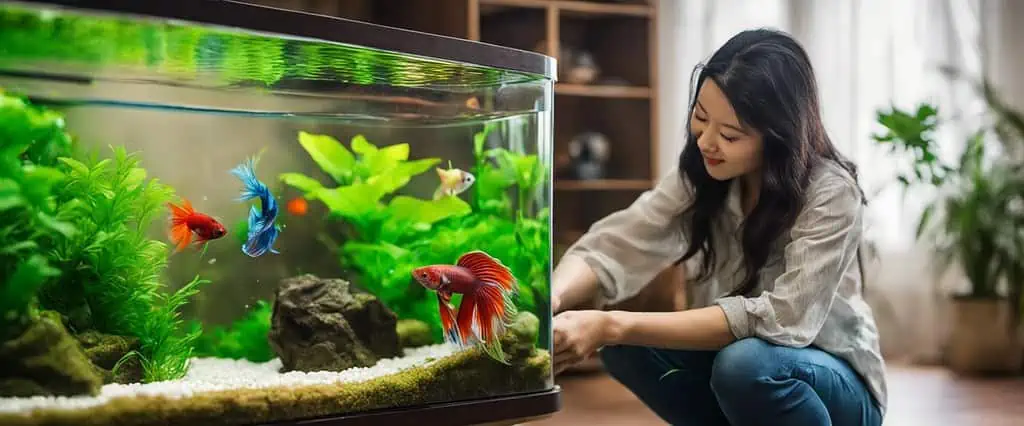My best friend got three betta fish in grade school for her birthday.
But all three died within about a month. When she got three more, they died too.
Betta fish are hugely popular for a good reason.
However, they require a lot more care than most people realize!
We’re here to help with this detailed Betta fish care guide to keep your fishy friends alive and healthy for a long time!

Table of Contents
Betta Fish Care Requirements

The betta splenden is often called the siamese fighting fish. They get this nickname because of their history.
Betta fish are native to Southeast Asia, specifically Thailand. There, they used to be pitted against each other for fish fights.
Domesticated bettas went through selective breeding for traits like aggression and dominance.
You’ve seen evidence of this if you’ve raised a few of them.
But not all betta fish display aggressive behavior or even act confident.
One of the things I love the most about this fish species is the wide range of personalities. I find them so charming!
Bettas are relatively small. The largest adults get about 3″ inches (or 7cm) long.
Despite their size, betta fish are carnivorous and sometimes predatory toward smaller aquarium species.
Their food is specialized to give them all the nutrients they need.
Don’t feed them any random fish food you find. It has to be specifically betta food.
Bettas are freshwater fish but have more detailed water requirements to stay healthy.
Water pH should stay between 6.5-7 for your betta to be comfortable, but they will tolerate slightly outside of this.
They tolerate a slightly wider range of temperatures, but ideally, you’ll keep them in a tank at 78-80° degrees Fahrenheit (27°C).
Take good care of your fish, and they can live happily for up to 5 years.
Dedicated Guides for Specific Needs
Betta Fish Tank Requirements
One reason it’s so hard to keep community tanks is that every fish species needs a slightly different environment.
Betta fish sometimes do well in a community aquarium, though, as long as the water is tolerable for them.
You also need to get the right tank size and decor to protect all your different pets.
For the initial tank setup, here’s what you will need:
- 5-gallon tank or larger
- Tank lid
- Thermometer
- Aquarium Heater
- Tank light
- Aquarium Plants
- Filter
- Water conditioner
- Water testing strips
- Water changing supplies
Our guide on how to set up a betta fish tank will teach how to put it all together.
Tank Size and Lid

Betta fish are often active and curious, so they need space to swim around.
A 5-gallon tank is excellent, especially if you only keep one fish. We’ve reviewed some of the best 5-gallon tank options here.
Some starter kits designed for bettas will give you something smaller, like a 2.5-gallon, but going with a tank smaller than 5 gallons is not recommended.
Using a smaller tank will make cleaning and maintaining much harder since you’ll have to do it more often.
Not to mention, having ample space is preferable for the fish itself.
When putting bettas in a community tank, be generous with the tank size. Some bettas are highly territorial.
By giving other fish plenty of spaces to hide and your betta lots of room to call their own, you end up with a much more peaceful environment.
Now, the reason you need to put a lid on your betta fish is simple. Betta fish jump and will leap out.
Betta fish swim right up to the top of the water often, so it’s extremely easy for them to launch themselves out of the tank.
For this reason:
- Do not fill your tank to the top.
- Get a lid to keep your fish contained!
- Choose a longer tank over a taller one.
You’re probably wondering why bettas swim to the surface of the water.
Many aquatic life forms get oxygen from the water they live in. But bettas get oxygen through their gills and gulp air from the surface.
This is because they have a unique body part called the labyrinth organ, whereas many fish only breathe with their gills. Kind of cool!
Water Temperature

It would be best if you kept a thermometer in the tank.
Remember, the best betta fish water temperature is between 78-80° degrees Fahrenheit (27°C). The goal is to keep the water here at all times.
If it drops by a degree or two, don’t panic! But do fix it as soon as possible.
You will need a heater to help keep the temperature up in your betta tank.
There are countless options out there. Remember to look past the sales tactics.
It doesn’t have to be a heater advertised for betta fish. It just needs to be reliable.
We don’t want too much fluctuation in the temp of your tank, even if it does stay within the golden range.
Flipping from 76° to 81° degrees Fahrenheit (27° C) and back every hour is enough to make your betta sick.
On a related note, direct sunlight may bring the temperature in your tank to dangerous levels.
Getting a light for your tank is an excellent way to exercise more control over your pet’s environment.
Not only are you able to keep them out of the sun and maintain the tank temperature. But you’re also better equipped to get them into a consistent sleep and wake routine.
Water Parameters
Here’s a complete list of water parameters:
- Temperature: 78-80° degrees Fahrenheit (27° C)
- pH: 6.5-7.0
- Ammonia Levels: 0 ppm
- Nitrite Levels: 0 ppm
- Nitrate Levels: < 40 ppm
As important as it is, there’s much more to maintaining your pet’s habitat than simply monitoring temperature.
These are the ideal betta fish water parameters. Aim for these ranges at all times.
Don’t fret too much over it. It doesn’t look very clear if you’ve never owned a fish before.
But it’s all more straightforward than it appears, and we’ll give you some tried and true tips for maintaining the chemical levels in your tank.
Why Plants for Betta Fish Are Important

Betta fish need plants in their tank for a few reasons:
- Hiding/resting
- Entertainment/stimulation
- Comfort
- Purifying/cleaning
Most fish like having little caves or other hiding places in their tank. Betta fish are no exception.
Even the most active and rowdy fish needs to slink away and rest sometimes.
Plants are great for making shady, dark hiding spots for your betta.
Ask any betta owner, and they’ll tell you these guys are known for being somewhat aggressive.
Problems like fin-biting and chasing get much worse when your fish isn’t well-stimulated.
Plants are a great way to fill up the tank. Your betta can weave around them and explore without getting bored so quickly.
If you have the means, cycle some different caves and decorations in the tank. These are good remedies for boredom and aggression.
Perhaps most importantly, betta fish need plants for comfort.
In their natural environment, bettas are surrounded by aquatic plant life. Therefore, keeping plants (real or fake) in the tank helps simulate their natural habitat.
On a related note, make sure you get safe plants and decorations. Nothing sharp belongs in your aquarium!
The safest fake plants are made with soft silk, not hard plastic or any other sharp material.
If you choose to get real plants, these will be good for purifying the water in your aquarium!
Tank Maintenance

It’s probably overwhelming to see such an extensive list of parameters.
But it isn’t as hard as you might think to maintain your betta tank.
If you have a community aquarium housing bettas, it’s even more important to do frequent water tests.
This is also true when you first set up the tank. Getting the water ready for your fish sometimes takes a little while.
Some aquatic life will produce a lot of ammonia or bacteria you don’t want to build up.
This is also an excellent reason to get a filter for your tank.
Technically, your betta will be okay without a filter. You just have to be vigilant and change the water much more often.
But using a filter helps keep those nitrite, nitrate, and ammonia levels down.
It’s also a good tool for controlling bacteria levels. So not only do filters keep a good handle on harmful bacteria, but they help good bacteria thrive.
We highly recommend using one!
Betta fish don’t like a strong current, though. So make sure your filter isn’t creating too much airflow.
Aside from checking the temperature and other parameters daily, you must cycle and treat the water.
Betta Fish Filtration & Lighting

Water Changes
You’re going to need to work water changes into your weekly schedule.
It’s not a very long process, though. So you’ll get used to it and be able to do it in under twenty minutes.
The important thing is changing the water a little bit at a time and using testing strips to check chemical levels.
Never do deep cleans on a betta tank.
Cleaning up algae is important, but it’s not good for your fish to change all their water at once.
This would kill good bacteria your betta needs to thrive.
Instead, do 25% water changes weekly and clean up the gravel with a siphon every month. This is safer all around!
Say you have a 5-gallon tank; this means changing about 1 gallon of water or a little more each week. (Remember, you aren’t filling the tank to the top!)
Always treat the water with a conditioner/dechlorinator and get it to the right temperature before it goes into the tank.
The best way to be sure it’s safe is to use a testing strip to see the chemical levels and check the temperature with a reliable thermometer.
Filtration

There are a million and one filters on the market. But betta fish do best with something simple and small.
A strong current is hard on their tiny bodies.
They tend to be slow swimmers as it is, and the extra airflow slows them down even more.
Sponge filters are one great option for a betta fish filter. They’re small, so they’re best for tanks of 15 gallons or smaller.
Unless you have a big community aquarium, the odds are good your betta tank setup is best suited for a small filter like this.
They’re also relatively inexpensive, usually only about $6-7.
If you have a bigger tank, we suggest using an internal filter. These are great because they let you adjust how much airflow there is in the tank.
As previously mentioned, having a weak current in your betta tank is best.
So, being able to turn down the airflow is a handy function to have.
These are a bit more expensive, depending on what size you get. They range in price from about $10 to about $30.
There are other filter options, but these are both great picks for your betta.
Adequate filtration will keep chemicals and harmful bacteria from reaching dangerous levels and help you control the airflow in the tank.
Lighting

We talked before about how direct sunlight is bad for your betta.
It heats the water in the tank, sometimes dangerously so. But it’s also a lot harder for you to control.
Don’t put your betta aquarium right in front of a window, especially if there are no curtains to block the sunlight.
Aquarium lights are widely available and usually pretty cheap.
Some have timers that let you pick a bedtime and wake-up time for your fish.
For a betta, you don’t necessarily need a timer unless your sleep schedule is all over the place (Mine is, I get it!) because bettas like to sleep at night and have fun during the day.
It’s easy to flick the light on when you get up and turn it off when you go to bed.
You do need to keep it as consistent as possible, though. Like many other pets, betta fish do best when you create a routine.
Betta Fish Diet

What Do Betta Fish Eat?
Betta fish are carnivorous, so their food is specialized and always contains meat or fish.
It’s crucial you buy specifically betta fish pellets and not just any fish food you find in the pet store.
Another option is to use betta fish flakes. These usually have the same essential ingredients as pellets and take a different form.
It’s also a great idea to feed your fish some extra treats outside of their pellets.
Bettas love mosquito larvae, daphnia, and brine shrimp as snacks. There are other treats as well.
Always exercise caution when buying treats at a pet store, though.
Keeping treats nutritious rather than feeding your fish empty carbs is important.
They aren’t very big and are susceptible to obesity and ensuing health issues.
How Much & How Often to Feed Betta Fish
If you’re feeding betta fish pellets, which we recommend, your betta gets 3-4 of them twice a day.
Make sure to feed the pellets one at a time, as this reduces food waste in the tank.
When you get them treats like mosquito larvae, offer them to your betta in moderation.
These are not daily food items, especially if you feed the recommended 6-8 pellets daily.
Obesity is hard on bettas, who are already slow swimmers. But, unfortunately, it also leaves them more susceptible to some of the common health issues we’ll touch on later.
Betta Fish Tank Mates

Best Tank Mates
Don’t keep two male betta fish together. It’s a recipe for disaster!
The territorial and aggressive behavior in betta fish is strongest in males. So if you keep two of them in the same tank, they’re liable to hurt each other.
Even in an 8-10 gallon tank or larger, it’s just a bad idea!
Remember, selective breeding brought these traits and behaviors out in betta fish. It’s instinctual for them at this point.
For the same reason, male betta fish are known for aggressive behavior against females.
Unless you have a betta breeding tank and are actively breeding, don’t put a male and female betta together.
If you have a male betta and want to find him a tank mate, here are some better options:
- Ghost or cherry shrimp
- Snails
- Rasboras
- Tetras
- Guppies
Here is our exhaustive list of betta tank mates if you need it.
Remember, you need to get a larger tank to house more fish.
Snails work fine in a 5-gallon tank. But 8-10 gallons is better for shrimp.
Spring for something bigger (longer, not taller!) if you want tetras or other fish.
Fifteen gallons is the minimum, especially since good betta tank mates are often schooling fish.
Bettas are bullies sometimes, so your other fish need plenty of cover and space.
Many of the best tank mates for the betta splenden are timid and non-aggressive. They tend to hide or flee before fighting.
Putting lots of plants in the tank helps with this!
But caves and plenty of space are also necessary when housing extra fish.
How Many Fish in One Tank?

There isn’t really a hard limit on how many fish belong in one tank. However, there are a lot of factors to consider!
- Tank size
- Water parameters
- Behavior/temperaments
The tank size is a big one! If you only have a 5-gallon tank, you might keep a couple of fish at the most.
In a 50-gallon aquarium, there’s obviously a lot more room for different fish species.
This being said, the precise number of fish for a given tank depends on the species.
You also must be careful about the water conditions for all your different fish!
Example: If we’re talking about a betta fish, you need at least a 15-gallon tank in order to add much of any other fish in there. However, six neon tetras will do fine in a 10-gallon tank.
Aquatic life is delicate.
Housing a tropical fish with one who prefers cold water is impossible.
A fish like a betta who likes neutral water cannot live with a molly, which prefers more alkaline water.
If you have a small school of neon tetras to house with a betta fish, you must ensure the water is suitable for both of them.
Example: Neon tetras like the pH at 6.8-7.8, and bettas like it at 6.5-7. To accommodate both fish, you have to keep the pH between 6.8-7.
You also need to consider the temperament of your fish.
Be picky choosing tank mates for a betta, and be careful not to put prey and their predators together.
Housing lots of calm fish together is very doable. But your options diminish once you get a more aggressive species in the tank.
Female Betta Fish Sorority

First and foremost, don’t keep a betta sorority if you haven’t raised betta fish before.
The more experience you have before starting this project, the better.
Here are the basic ground rules for a female betta fish sorority:
- Get a 40-gallon or bigger aquarium
- Add lots of plants
- Be vigilant
When you set up the tank for your sorority, you must ensure it’s incredibly spacious. Forty gallons is the minimum, which I know sounds enormous.
But the more space you give your fish, the safer and more comfortable they will be.
Plants are going to add to their comfort as well as keep them stimulated.
Even in a perfect environment designed to reduce violence, betta fish get aggressive.
Males are often more aggressive than females, but this does not mean female bettas won’t fight.
Keep a close eye on your aquarium, especially right after you put your fish in.
Look for signs of stress or fighting, like constant hiding, loss of appetite, or nipped fins.
Tank Dividers for Multiple Betta Fish
Use tank dividers if you want to keep multiple betta fish but are not experienced enough to start a sorority.
You still need to get a larger aquarium to give your fish enough space.
But you won’t have to worry so much about fighting. Also, you won’t need to take extra care to keep an eye on the tank at all times.
Do be aware of possible signs of stress or illness in your fish.
If an aggressive betta flares a lot at a calm betta from the other side of the tank, this can cause a lot of stress in the more timid fish.
Betta Fish Diseases

Signs of a Healthy Betta Fish
You’ll get to know your betta well before long. Then you’ll have a better idea than we do what they look like when they’re healthy.
In the meantime, we can tell you what is considered grossly normal for a betta.
Betta fish are slow but strong swimmers and spend lots of time moving around the tank during the day.
Depending on the temperament of your fish, they may spend more or less time hiding away in plants or caves you keep in the tank.
You’ll see your betta swim up to the surface of the water. This is because they are labyrinth fish, and this is how they get oxygen in addition to using their gills.
They also often flare when they feel territorial or want to mate. Some bettas, though, flare very rarely.
Again, you will get to know your pet and learn what is and is not normal for them.
Appetite is a significant indicator of a healthy betta and doesn’t vary as much from fish to fish.
A healthy betta splenden will eat their pellets eagerly and possibly even come up to the glass to silently beg for more.
Signs of a Sick Betta Fish

One of betta fish’s most common health issues is fin rot, a bacterial problem.
A betta with this issue will have the following:
- Brown or red fin discoloration
- Frayed or ragged fin appearance
If you see these problems, the odds are good the healthy bacteria in your tank are not winning over the harmful bacteria.
You may also be having problems with algae growth.
Do more frequent water changes until the problem clears up and your fish has clean water to swim around in. Usually, this is all it takes.
Other signs of stress and illness vary. But here is a list of symptoms for common health issues:
- Paler colors than normal
- Stress stripes
- Clamped fins
- Lethargy
- New spots on the skin
- Swimming sideways or floating
Some of these are merely signs of stress. Others indicate more severe illnesses like fungal infections or Swim Bladder Disease.
If your betta is acting off and you aren’t sure what’s wrong, call a vet for help.
Keeping Your Betta Fish Healthy
Despite being extremely popular as first pets for kids and adults alike, betta fish are complicated lifeforms.
They need specific water parameters, frequent water changes, a consistent and healthy diet, and a thoughtful tank set-up.
If you give them a tank mate, you also have to keep an eye out for symptoms of stress!
We aim to help aquarists of all levels take care of their fish. So send this article to your betta-loving friends, whether they’re masters or newbies.


